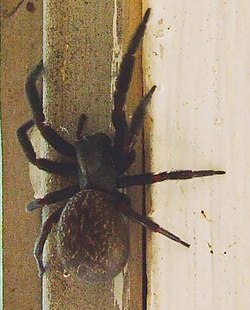| Desidae Temporal range: | |
|---|---|
 | |
| Badumna insignis | |
 | |
| Badumna longinqua | |
| Scientific classification | |
| Kingdom: | Animalia |
| Phylum: | Arthropoda |
| Subphylum: | Chelicerata |
| Class: | Arachnida |
| Order: | Araneae |
| Infraorder: | Araneomorphae |
| Family: | Desidae Pocock, 1895 |
| Diversity | |
| 63 genera, 324 species | |
Desidae is a family of spiders, some of which are known as intertidal spiders. The family is named for the genus Desis , members of which inhabit the intertidal zone. The family has been reevaluated in recent years and now includes inland genera and species as well, such as Badumna and Phryganoporus .
Contents
In 2017, the family Amphinectidae was merged into Desidae and the family Toxopidae was separated from it. [1] Those intertidal spiders that are truly marine commonly live in barnacle shells, which they seal up with silk; this allows them to maintain an air bubble during high tide. They emerge at night to feed on various small arthropods that live in the intertidal zone.